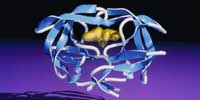

The following two facts dramatically illustrate the explosive growth in structure-based drug design in the last few years.
*Mid-Eighties - about 10 protein structure-based drug design-related projects going on worldwide.
*Mid-Nineties - close to 200 structure determinations that have been performed worldwide on a single protein, HIV protease, complexed with a large variety of inhibitors.
The tremendous increase in detailed structural knowledge of medically relevant proteins is due to several factors.
All these developments have resulted in an exponential growth in the number of protein structures solved. Excluding mutants and complexes with small ligands, 226 structures were published in 1992. This is certainly an underestimate of the number of new structures solved, since many protein structures are kept classified by pharmaceutical companies. The rate of structure determinations has doubled in the last two years, and this rate is still increasing. In January 1998, there were 6151 protein structures in Protein Data Bank (PDB). In November 1998, 8085 protein structures have been released.
The large number of structural investigations on medically relevant proteins reflects the general recognition that the structure of a potential drug target is very precious knowledge for a pharmaceutical company, not only for lead discovery and lead optimization but also in the later phases of drug development - stages where issues such as toxicity or bioavailability may crop up. At these late stages, knowledge of the binding mode of potential drug candidates to the target protein makes it easier to modify the compound in a rational manner.
There is often a long road between the discovery or design of a tightly-binding inhibitor of a target protein and the commercial availability of a drug.
The criteria for allowing a new compound to be administered to large populations need to be quite stringent, and this is the main reason for the failure of compounds to become useful drugs. To predict how a new compound will change the delicate balance of all metabolic, transport and signalling pathways in the human body is simply impossible, no matter how much pharmacological and toxicological know-how has been invested in tailoring of the compound for use in humans. Hence, many promising compounds will unfortunately have to be rejected when they are found to show unacceptable side effects in humans.
The emergence of structure-based drug design as a new technology is nevertheless afascinating development of major, worldwide importance. The final verdict on the power of this method will not be clear for one or two decades, since it will take this long for enough cases to be studied to arrive at a statistically valid conclusion. At present, the field is exciting and full of surprising results.
Structure-Based Drug Design
Finding leads
Optimizing leads
Tools for structure-based drug design
Three-dimensional ligand databases
Drug resistance in infectious diseases and cancer
Progress and successes
Vertex Pharmaceuticals
- a leader in the use of structure-based drug design
References